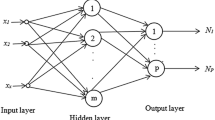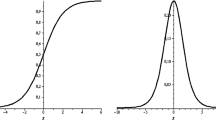Abstract
For the nearly exponential type of feedforward neural networks (neFNNs), it is revealed the essential order of their approximation. It is proven that for any continuous function defined on a compact set of R d, there exists a three-layer neFNNs with fixed number of hidden neurons that attain the essential order. When the function to be approximated belongs to the α-Lipschitz family (0 < α ⩽ 2), the essential order of approximation is shown to be O(n −α) where n is any integer not less than the reciprocal of the predetermined approximation error. The upper bound and lower bound estimations on approximation precision of the neFNNs are provided. The obtained results not only characterize the intrinsic property of approximation of the neFNNs, but also uncover the implicit relationship between the precision (speed) and the number of hidden neurons of the neFNNs.
Similar content being viewed by others
References
Attali J G, Pages G. Approximation of functions by a multilayer perception: A new approach. Neural Networks, 1997, 10: 1069–1081
Cardaliaguet P, Euvrard G. Approximation of a function and its derivatives with a neural networks. Neural Networks, 1992, 5: 207–220
Cao F L, Xu Z B. Neural network approximation for multivariate periodic functions: estimates on approximation order. Chinese Journal of Computers, 2001, 24(9): 903–908
Chui C K, Li X. Approximation by ridge functions and neural networks with one hidden layer. J Approx Theory, 1992, 70: 131–141
Chui C K, Li X. Neural networks with one hidden layer. In: Multivariate Approximation. Jetter K, Utreras F I, eds. From CAGD to Wavelets. Singapore: World Scientific Press, 1993. 77–89
Chen T P, Chen H. Universal approximation to nonlinear operators by neural networks with arbitrary activation functions and its application to a dynamic system. IEEE Transaction on Neural Networks, 1995, 6: 911–917
Chen T P. Approximation problems in system identification with neural networks, Sci China Ser A-Math, 1994, 24(1): 1–7
Hornik K, Stinchombe M, White H. Universal approximation of an unknown mapping and its derivatives using multilayer feedforward networks. Neural Networks, 1990, 3: 551–560
Jackson D. On the approximation by trigonometric sums and polynomials. Trans Amer Math Soc, 1912, 13: 491–515
Cybenko G. Approximation by superpositions of sigmoidal function. Math of Control Signals and System, 1989, 2: 303–314
Funahashi K I. On the approximate realization of continuous mappings by neural networks. Neural Networks, 1989, 2: 183–192
Yoshifusa I, Approximation of functions on a compact set by finite sums of sigmoid function without scaling. Neural Networks, 1991, 4: 817–826
Kurkova V, Kainen P C, Kreinovich V. Estimates for the number of hidden units and variation with respect to half-space. Neural Networks, 1997, 10: 1068–1078
Mhaskar H N, Micchelli C A. Approximation by superposition of a sigmoidal function. Advances in Applied Mathematics, 1992, 13: 350–373
Mhaskar H N. Neural networks for optimal approximation for smooth and analytic functions. Neural Comput, 1996, 8: 164–177
Mhaskar H N, Micchelli C A. Degree of approximation by neural networks with a single hidden layer. Advances in Applied Mathematics, 1995, 16: 151–183
Mhaskar H N, Khachikyan L. Neural networks for functions approximation. In: Makhoul J, Manolakos E, Wilson E, eds. Neural Networks for Signal Processing, Proc. 1995 IEEE Workshop, Vol. V, F. Girosi (Cambridge, MA). New York: IEEE Press, 1995. 21–29
Mhaskar H N, Micchelli C A. Dimension-independent bounds on the degree of approximation by neural networks. IBM J Res Develop, 1994, 38: 277–284
Maiorov V, Meir R S. Approximation bounds for smooth functions in C(R d) by neural and mixture networks. IEEE Trans on Neural Networks, 1998, 9: 969–978
Suzuki S. Constructive function approximation by three-layer artificial neural networks. Neural Networks, 1998, 11: 1049–1058
Ritter G. Jackson’s theorems and the number of hidden units in Neural networks for uniform approximation. Univ Passau, Fak Math Inform, Technical Report, MIP9415, 1994
Xu Z B, Cao F L. The essential order of approximation for neural networks. Sci China Ser F-Inf Sci, 2004, 47: 97–112
Ritter G. Efficient estimation of neural weights by polynomial approximation. IEEE Trans on Information Theory, 1999, 45: 1541–1550
Feinerman R P, Newman D J. Polynomial Approximation. Baltimore, MD: Williams & Wilkins, 1974
Nikol’skii S M. Approximation of functions of several variables and imbedding theorems. Berlin, Heidelberg, New York: Springer, 1975
Soardi P M. Serie di fouroer in piú variabili. Quad dell’Unione Mat Italiana, Vol. 26. Bologna: Pitagora Editrice, 1984
Ditzian Z, Totik V. Moduli of Smoothness, New York: Springer-Verlag, 1987
Johnen H, Scherer K. On the equivalence of the K-functional and modulus of continuity and some applications. In: Schempp W, Zeller K eds. Constructive Theory of Functions of Several Variable. Berlin: Springer-Verlag, 1977. 119–140
Hornik K, Stinchombe M, White H. Multilayer feedforward networks are universal approximation. Neural Networks, 1989, 2: 359–366
Leshno M, Lin V Y, Pinks A, Schocken S. Multilayer feedforward networks with a nonpolynomial activation function can approximate any function. Neural Networks, 1993, 6: 861–867
Author information
Authors and Affiliations
Corresponding author
Rights and permissions
About this article
Cite this article
Xu, Z., Wang, J. The essential order of approximation for nearly exponential type neural networks. SCI CHINA SER F 49, 446–460 (2006). https://doi.org/10.1007/s11432-006-2011-9
Received:
Accepted:
Issue Date:
DOI: https://doi.org/10.1007/s11432-006-2011-9




